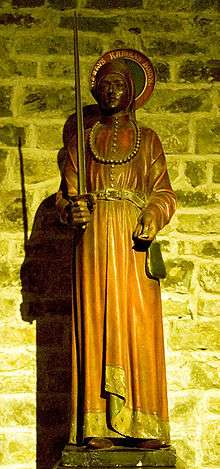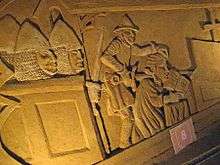Charles I, Count of Flanders
| Charles the Good | |
|---|---|
 Statue in the Basilica of the Holy Blood, Bruges | |
| Born |
1084 Odense, Denmark |
| Died |
2 March 1127 Bruges, County of Flanders (now Belgium and northern France) |
| Beatified | 1884 |
| Feast | 2 March |
Blessed Charles the Good (1084 – 2 March 1127) was Count of Flanders from 1119 to 1127. His murder and its aftermath were chronicled by Galbert of Bruges.
Life
Charles was born in Denmark, only son of the three children of King Canute IV (Saint Canute) and Adela of Flanders.[1] His father was assassinated in Odense Cathedral in 1086,[2] and Adela fled back to Flanders, taking the very young Charles with her but leaving her twin daughters Ingeborg and Cecilia in Denmark. Charles grew up at the comital court of his grandfather Robert I and uncle Robert II. In 1092 Adela went to southern Italy to marry Roger Borsa, duke of Apulia, leaving Charles in Flanders.
Charles travelled to the Holy Land in 1107 or 1108 with a fleet of English, Danes and Flemings.[3] This is possibly the fleet of Guynemer of Boulogne, described similarly. He was offered the crown of the Kingdom of Jerusalem but refused for reasons unknown.[4]
In 1111 Robert II died, and Charles' cousin Baldwin VII became count. Charles was a close advisor to the new count (who was several years younger), who around 1118 arranged Charles' marriage to the heiress of the count of Amiens, Margaret of Clermont, daughter of Renaud II, Count of Clermont.[5] The childless count Baldwin was wounded fighting at the Battle of Bures-en-Brai in September 1118, and he designated Charles as his successor before he died on 17 July 1119.[6]
In 1125 Charles expelled Jews from Flanders, attributing their price gouging as a cause of additional suffering during the famine which afflicted his domains in that year.[7] During the famine, Charles distributed bread to the poor, and took action to prevent grain from being hoarded and sold at excessively high prices.[8] Prodded by his advisors, he also began proceedings to reduce the influential Erembald family, which was heavily engaged in this activity, to the status of serfs. As a result, Fr. Bertulf FitzErembald, provost of the church of St. Donatian, masterminded a conspiracy to assassinate Charles and his advisors.
Death

On the morning of 2 March 1127, as Charles knelt in prayer in the church of St. Donatian, a group of knights answering to the Erembald family entered the church and hacked him to death with broadswords.[9][10]
Legacy
The brutal and sacrilegious murder of the popular count provoked widespread public outrage, and he was almost immediately regarded popularly as a martyr and saint, although not formally beatified until 1882.[lower-alpha 1]
The Erembalds, who had planned and carried out the murder of Charles, were besieged inside the castle of Bruges by the enraged nobles and commoners of Bruges and Ghent. All the conspirators were defeated, captured, and tortured to death.
In the aftermath, King Louis VI of France, who had supported the uprising against the Erembalds, used his influence to select William Clito as the next Count of Flanders.[11]
Ancestry
| Ancestors of Charles I, Count of Flanders | ||||||||||||||||||||||||||||||||||||||||||||||||||||||||||||||||||||||||||||||||||||||||||||||||||||||||||||||||||||||||||||||||||||||||||||||||||||||||||||||||||||||||||||||||||||||||||||||||||||||||||||||||||||||||||||||||||||||||||||||||||||||||||||||||||||||||||||||||||||||||||||||||||||||||||||||||||||||||||||||||||||||||||||||||||||||||||||||||||||||||||||||||||||||||||||||||||||||||||||||||||||||||||||||||||||||||||||||||||||||||||||||||||||||||||||||||||||||||||||||||||||||||||||||||||||||||||||||||||||||||||||||||||||||||||||||||||||||||||||||||||||||||||||||||||||||||||||||||
|---|---|---|---|---|---|---|---|---|---|---|---|---|---|---|---|---|---|---|---|---|---|---|---|---|---|---|---|---|---|---|---|---|---|---|---|---|---|---|---|---|---|---|---|---|---|---|---|---|---|---|---|---|---|---|---|---|---|---|---|---|---|---|---|---|---|---|---|---|---|---|---|---|---|---|---|---|---|---|---|---|---|---|---|---|---|---|---|---|---|---|---|---|---|---|---|---|---|---|---|---|---|---|---|---|---|---|---|---|---|---|---|---|---|---|---|---|---|---|---|---|---|---|---|---|---|---|---|---|---|---|---|---|---|---|---|---|---|---|---|---|---|---|---|---|---|---|---|---|---|---|---|---|---|---|---|---|---|---|---|---|---|---|---|---|---|---|---|---|---|---|---|---|---|---|---|---|---|---|---|---|---|---|---|---|---|---|---|---|---|---|---|---|---|---|---|---|---|---|---|---|---|---|---|---|---|---|---|---|---|---|---|---|---|---|---|---|---|---|---|---|---|---|---|---|---|---|---|---|---|---|---|---|---|---|---|---|---|---|---|---|---|---|---|---|---|---|---|---|---|---|---|---|---|---|---|---|---|---|---|---|---|---|---|---|---|---|---|---|---|---|---|---|---|---|---|---|---|---|---|---|---|---|---|---|---|---|---|---|---|---|---|---|---|---|---|---|---|---|---|---|---|---|---|---|---|---|---|---|---|---|---|---|---|---|---|---|---|---|---|---|---|---|---|---|---|---|---|---|---|---|---|---|---|---|---|---|---|---|---|---|---|---|---|---|---|---|---|---|---|---|---|---|---|---|---|---|---|---|---|---|---|---|---|---|---|---|---|---|---|---|---|---|---|---|---|---|---|---|---|---|---|---|---|---|---|---|---|---|---|---|---|---|---|---|---|---|---|---|---|---|---|---|---|---|---|---|---|---|---|---|---|---|---|---|---|---|---|---|---|---|---|---|---|---|---|---|---|---|---|---|---|---|---|---|---|---|---|---|---|---|---|---|---|---|---|---|---|---|---|---|---|---|---|---|---|---|---|---|---|---|---|---|---|---|---|---|---|---|---|---|---|---|---|---|---|---|---|---|---|---|---|---|---|---|---|---|---|---|---|---|---|---|---|---|---|---|---|---|---|---|---|---|---|---|---|---|---|---|---|---|---|---|---|---|---|---|---|---|---|---|---|---|---|---|---|---|---|---|---|---|---|---|---|---|---|---|---|---|---|---|---|---|---|---|---|---|---|---|---|---|---|---|---|---|---|---|---|---|---|---|---|---|---|---|---|---|---|---|---|---|---|---|---|---|---|---|---|---|---|---|---|---|---|---|---|---|---|---|---|---|---|---|
| ||||||||||||||||||||||||||||||||||||||||||||||||||||||||||||||||||||||||||||||||||||||||||||||||||||||||||||||||||||||||||||||||||||||||||||||||||||||||||||||||||||||||||||||||||||||||||||||||||||||||||||||||||||||||||||||||||||||||||||||||||||||||||||||||||||||||||||||||||||||||||||||||||||||||||||||||||||||||||||||||||||||||||||||||||||||||||||||||||||||||||||||||||||||||||||||||||||||||||||||||||||||||||||||||||||||||||||||||||||||||||||||||||||||||||||||||||||||||||||||||||||||||||||||||||||||||||||||||||||||||||||||||||||||||||||||||||||||||||||||||||||||||||||||||||||||||||||||||
Notes
- ↑ At the Petit Palais Museum in Paris there is a remarkable painting of his funeral by the Belgian artist Jan van Beers (1852–1927).
References
- ↑ Nicholas 1992, p. 56.
- ↑ Hundahl, Kjær & Lund 2016, p. 87.
- ↑ Galbert of Bruges 2013, p. 25.
- ↑ Riley-Smith 1997, p. 176.
- ↑ Galbert de Bruges 2013, p. 42.
- ↑ Paul 2012, p. 43-44.
- ↑ Deutsch & Bloch 1906.
- ↑ Nicholas, 1992 & 62.
- ↑ Davies 1997, p. 10.
- ↑ Nicholas 1992, p. 63.
- ↑ Aird 2008, p. 272.
- ↑ Sturluson, Snorri; Hollander, Lee M. (1964). Heimskringla. University of Texas Press. p. 408. ISBN 9780292730618. Retrieved 28 February 2018.
- 1 2 Bricka, Carl Frederik, Dansk Biografisk Lexikon, vol. XVII [Svend Tveskjæg – Tøxen], 1903, pp.3–5.
- ↑ Stefan Pajung, Knud den Hellige ca. 1042–1086, danmarkshistorien.dk, Aarhus University, 22 January 2010
- 1 2 Dansk Kvindebiografisk Leksikon (in Danish)
- 1 2 Richardson, Douglas (2013). Royal Ancestry: A Study in Colonial and Medieval Families. V. Salt Lake City, Utah: Royal Ancestry Series. p. 497.
- 1 2 Galbert of Bruges 2013, p. 81.
- 1 2 Detlev Schwennicke, Europäische Stammtafeln: Stammtafeln zur Geschichte der Europäischen Staaten, Neue Folge, Band II (Marburg, Germany: Verlag von J. A. Stargardt, 1984), Tafel 11
- 1 2 Freytag, Hans-Joachim, "Bernhard II." in: Neue Deutsche Biographie 2 (1955), S. 112 [Online-Version]; URL: https://www.deutsche-biographie.de/pnd138734895.html#ndbcontent
- 1 2 "Eilika Schweinfurt" (in French). Histoire de l'Europe et de la Mediterranee.
Sources
- Aird, William M. (2008). Robert Curthose, Duke of Normandy: C. 1050–1134. The Boydell Press.
- Davies, Ralph Henry Carless (1997). King Stephen. Routledge.
- Deutsch, Gotthard; Bloch, Armand (1906). "Ghent". Jewish Encyclopedia.
- Galbert of Bruges (2013). The Murder, Betrayal, and Slaughter of the Glorious Charles, Count of Flanders. Translated by Rider, Jeff. Yale University Press.
- Hundahl, Kerstin; Kjær, Lars; Lund, Niels, eds. (2016). Denmark and Europe in the Middle Ages, C.1000–1525: Essays in Honour of Professor Michael H. Gelting. Routledge.
- Nicholas, David (1992). Medieval Flanders. Longman.
- Paul, Nicholas L. (2012). To Follow in Their Footsteps: The Crusades and Family Memory in the High Middle Ages. Cornell University Press.
- Riley-Smith, Jonathan (1997). The First Crusaders, 1095–1131. Cambridge University Press.
External links
| Preceded by Baldwin VII |
1119–1127 |
Succeeded by William |
| Wikimedia Commons has media related to Charles I of Flanders. |